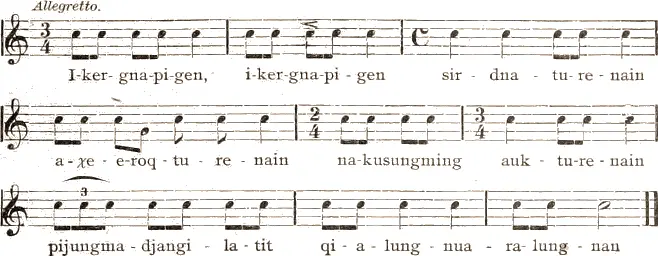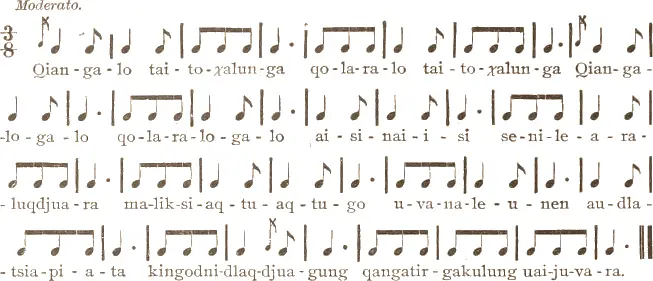Merrymaking Among the Tornit
Table of Contents

The Eskimo reciting this song jump up and down and to the right and left with their legs bent and their hands hanging down, the palms touching each other. In crying aq! aq! they jump as high as possible.
Table of Contents

Besides these old songs and tales there are a great number of new ones, and, indeed, almost every man has his own tune and his own song. A few of these become great favorites among the Eskimo and are sung like our popular songs. The summer song ( No. I) and “The returning hunter” ( No. II) may be most frequently heard. As to the contents of the songs, they treat of almost everything imaginable: of the beauty of summer; of thoughts and feelings of the composer on any occasion, for instance, when watching a seal, when angry with somebody, &c.; or they tell of an important event, as of a long journey. Satiric songs are great favorites.
The form of both old and new songs is very strict, they being divided into verses of different length, alternating regularly. I give here some examples:
Arlum Pissinga (the killer’s song)
Table of Contents

I. The killer’s song:
(1) Qiangalo taitoχalunga,
Qolaralo taitoχalunga
Qiangalogalo
Qolaralogalo
Aisinaisi. 15
(2) Senilearaluqdjuara
Maliksiaqtuaqtugo.
Uvanaleunen
Audlatsiapiata
Kingodnidlaqdjuagung
(3) Qangatirgakulung uaijuvara.
II. Summer song:
Aja.
(1) Ajaja adlenaipa.
Adlenaitariva silekdjua una aujaratarame
Ajaja, Ajaja!
Aja!
(2) Ajaja adlenaipa
Adlenaitariva silekdjua una tektorotikelektlune.
Ajaja, Ajaja.
Aja!
(3) Ajaja nipituovokpan!
Nipituovokpan kouvodlalimokoa nunatine aujadle
Ajaja, Ajaja
Aja!
&c.
III. Utitiaq’s song:
Aja!
(1) Adlenaipunganema adlenait.
Adlenaipunganema
Adlenaipunganema adlenait,
Aja!
(2) Sikuqdjualimena adlenait.
Atoqpoqtaromena
Tanerangitu adlenait.
Aja!
&c.
IV. Kadlu’s song:
(1) Odlaqē´, odlaqē´, odlaqē´.
Odlaqē´ saranga tutaranga atujang una ajajaja.
Odlaqē´ atedlirlungai aχigirn qodlusuaning aχiatungitunga ajaja.
Nettiulunga iχatijetingirn pinassousirdlunirn pinasuatautlirpadlirunirn.
(2) Odlaqē´, odlaqē´, odlaqē´.
Odlaqē´ saranga tutaranga atujang una ajajaja.
Odlaqē´ atedlirlungai aχigirn qodlusuaning aχiatungitunga ajaja.
Ugjurutlarunirn iχatijitingirn pinassousirdlunirn pinasuatautlirpadlirnunirn.
(3) ....&c.
Some of these verses contain only a single word, the rhythm being brought about by the chorus aja, amna aja, &c. I add two examples of this kind:
V. Song in the language of the Angakut:
Ajarpaija taitlaniqdjuaq ajarpe aitarpik ajijaija.
Ajarpaija ataqdjuaq ajarpe aitarpik ajijaija.
Ajarpaija mingeriaqdjuaq ajarpe aitarpik ajijaija.
VI. Oχaitoq’s song:
Aja.
(1) Tavunga tavunga tavunga tavunga
Tavunga tavunga tavunga tavunga tavungadlo tavunga
Aja.
(2) Pissutaramaima tavunga tavunga.
Pissutaramaima tavunga tavunga tavungadlo tavunga, &c.
The rhythm of the songs will best be understood by examining the melodies. Every long syllable may be replaced by two or even three short ones; other short syllables appear as unaccented parts before the accented part of a measure; in short, the rhythmic adaptation of the words to the melody is very arbitrary and interchanges frequently occur, so that it is impossible to speak of metric feet. At the same time this furnishes distinct proof that the musical rhythm is the decisive element in determining the form. The rhythmic arrangement of the words is regulated with considerable exactness by the quantity of the syllables, and not by the accent. While, for instance, in speaking, it would be “palirtu´gun,” in song No. IV it is “palir´tugun´,” and in No. I “tekto´roti´kelek´tlune,” instead of “tektorotikelektlu´ne,” &c. Such displacements of the accent, however, are avoided if possible, and in the best and most popular songs they hardly appear at all.
The construction of the songs corresponds entirely with that of the music, inasmuch as every melody and every rhythmically spoken song is made up of musical, that is, rhythmic, phrases which are divided by cæsuræ. Repetitions of the same phrases are very frequent. The adaptation of the melodies to our divisions of time and measure is also somewhat arbitrary, as they frequently consist of a mixture of three and four part phrases. It is for this reason that I have noted down some songs without any division into bars or measures and in those cases have only marked the accented syllables.
Among the twenty melodies and rhythmic poems we find ten of binary measures, five of triple measures, and six of mixed ones. Of the whole number, nine begin on the full bar, eleven on the arsis.
The melodies move within the following range: In a fifth (No. III), one; in a minor sixth (Nos. VII, IX, X), three; in a major sixth (Nos. II, IV, XVII), three; in a seventh (Nos. XII, XIV), two; in an octave, (Nos. I, II, V, VIII, XI, XVI), six; in a minor ninth (No. VI), one; in a major ninth (No. V), one; in a tenth (No. XIII), one.
These may be divided into two very characteristic and distinct groups. The first, which would coincide with our major key, contains the following essential tones:

The fourth and the sixth occur seldom, and then only as subordinate tones. This key is identical with the Chinese and many of the Indian ones.
In the second group, which corresponds to our minor key, we frequently find the fourth, while the sixth only appears twice and then as a subordinate tone (in No. XV). We furthermore find the major seventh in the lower position leading back to the beginning, i.e., the key note. The essential components of this key are:

Professor R. Succo calls attention to the fact that the relation of the melodies to their key note resembles that of the Gregorian chants, especially the psalmodic ones among them.
If we, in accordance with our ideas, suppose the melody—No. XIII, for example—to begin in C major, it nevertheless does not conclude in the same key, but in E. We would say that No. XIV is written in A minor; still it ends in E. We find the same in the Gregorian chants. They also resemble the songs of the Eskimo in the retention of the same note during a large number of consecutive syllables.
On the whole the melodies, even to our musical sense, can be traced to a key note. However, changes often occur as well (see No. VI). A very striking construction appears in No. XIII, where the oft-repeated E forms a new key note, while at the conclusion the melody leaps back without any modulation to C through the peculiar interval, ḇ, c.
Читать дальше

















